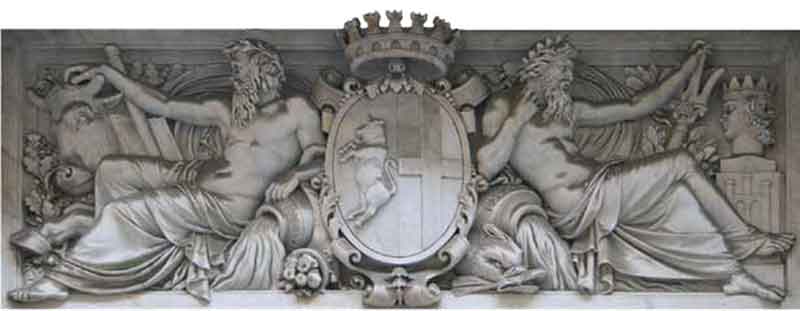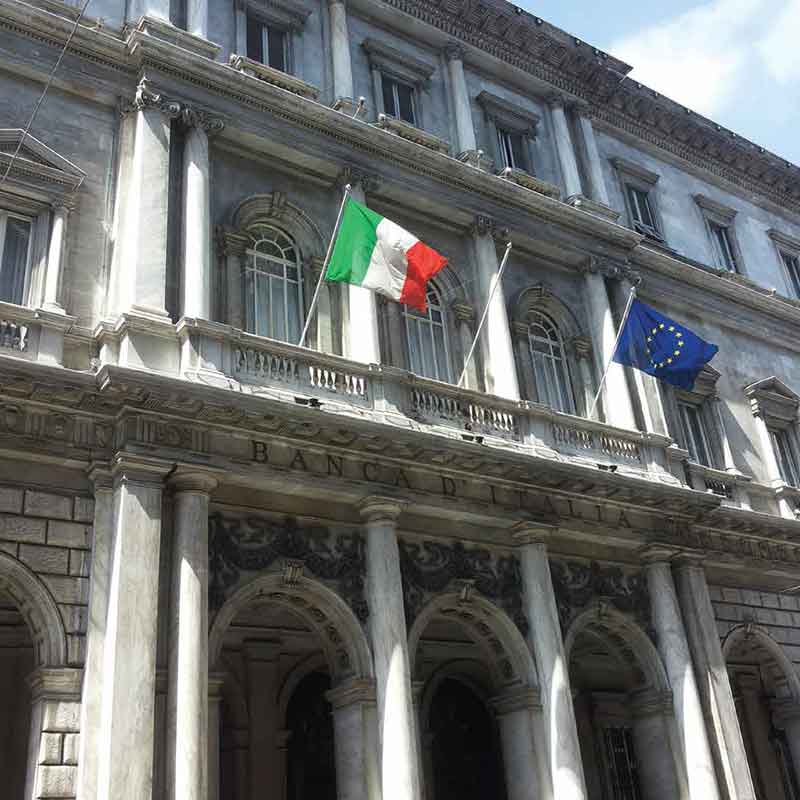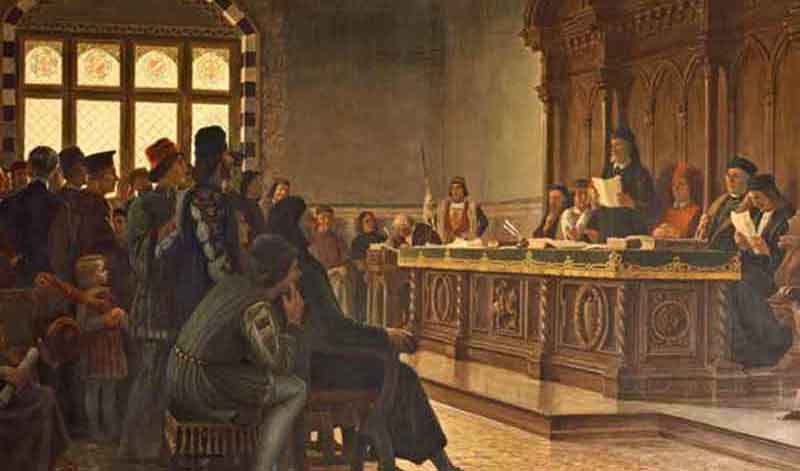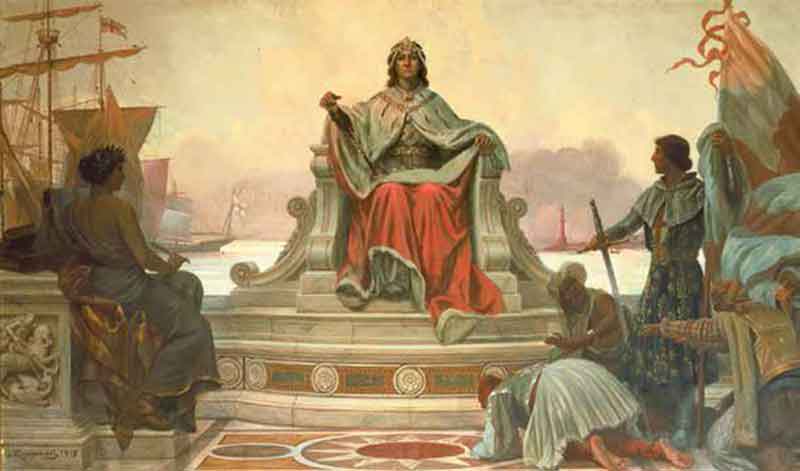
Background
Between the late nineteenth and early twentieth centuries, Genoa's rapid economic growth, fuelled by its coastal location and viable transport system and by substantial State benefits, prompted the Bank of Italy (founded by the transformation of Banca Nazionale nel Regno d'Italia) to acquire new, functional and prestigious headquarters for its branch. Thus a project was drawn up for the construction of Palazzo De Gaetani, which was completed on May 22, 1916.
During its first twenty years in the new building, the Genoa Branch was not only involved in financing the ongoing economic development, but also witnessed the introduction of the two Banking Laws of 1926 and 1936, enacted in response to the repeated credit crunches that had proved particularly serious in Genoa.
From the 1930s to the 1970s, the State's role in the direct management of the industrial system, with its consequences for the Treasury, became increasingly important for the country as a whole and especially for Genoa. The operation of Italy's largest port entailed major commitments in the fields of foreign exchange and exchange control.
The 1980s and 1990s saw the gradual dismantling of the State holding companies, which seriously depleted Genoa's industrial system, already under pressure from competitiveness problems in the shipping and port services sector. The Branch's activities were cut back and a number of traditional tasks were gradually automated.
Towards the close of the twentieth century, it seemed that a recovery was under way - in Liguria, too - helped by the economic and financial stability that followed the introduction of the Euro. In Genoa, economic growth hinged increasingly on high-tech industries, knowledge-intensive services, tourism and a newly dynamic shipping industry. This was the situation at the onset the crisis of 2007-08 and subsequent recession.
After the long and deep crisis it is time to make a new start, based on innovative production concepts and methods of sustainable development. The Bank is participating in this trend, focusing strongly on energy conservation and on reducing its carbon footprint. The investment in the renovation of Palazzo de Gaetani's main facilities is part of this strategy: the solutions adopted, architectural and for installations (roofing, window fixtures and central heating), are designed to achieve maximum energy saving; they are emblematic of the Bank's desire to ensure that everything it undertakes at the service of the country and the local community is also environmentally sustainable.

The building
The building was tested and then inaugurated on May 22, 1916. In the same month, the annual general meeting took place, attended by the Director General Bonaldo Stringher. The building had cost just under 3 million lire. High quality materials were used: the facade is entirely covered in white Carrara marble.
The Public Hall on the ground floor is decorated with marble, stucco, stained-glass panels, and thirteen large canvases by Giovanni Capranesi (1852-1921), Gaetano Miolato (1885-1960) and Antonio Orazio Quinzio (1856-1928), depicting iconic moments in the history of Genoa. The second floor houses paintings, bronzes, ceramics and sculptures from different periods.
In the Council Room hangs a large Gobelin tapestry, woven in the late seventeenth century, representing The Judgment of Paris and there are two white marble busts portraying Carlo Bombrini and Camillo Cavour; in a band below the ceiling are the coats of arms of the cities in which the Bank of Italy had branches when the Palazzo was built. The vault contains 4,453 safe deposit boxes, a service that was instituted in 1922 and terminated in 1972.

The Centennial
On May 22, 2016, to mark one hundred years since the inauguration of Palazzo de Gaetani, the Genoa Branch of the Bank of Italy, assisted by some of the head office departments, published a book on the origin and history of the building, which bears the traces of many successive adaptations to operational needs. Much of the book is devoted to images and original documents from different eras, taken for the most part from the Branch's own historical archive, which has over 6,000 items on catalogue and is one of the richest in the Bank's entire network. The book was presented, together with the annual report on the regional economy, at a conference held on June 8, 2016, attended by representatives of the government and the institutions, academics, and the financial authorities of the city and region.
The six chapters of the book span the whole period from 1843 (foundation of Banca di Genova, forerunner of the Bank of Italy) to the present day. The history of Palazzo de Gaetani runs on two parallel tracks, representing the main drivers of the demand for the Genoa Branch's services: the local economy and local finance on one side and the functions and duties of the Bank of Italy on the other. The objective is not to paint a complete history but to outline the main events, at significant moments in the Bank's past, that shaped its role in this territory.
The presentation of the book, on June 8, was well attended. Archbishop Cardinal Angelo Bagnasco gave a welcoming speech. The Director of the Branch, Mario Venturi, recalled the origins of the building near Piazza De Ferrari, remarking that Palazzo de Gaetani has retained most of its original features despite all the adaptations, many of which served to keep pace with the constant reallocation of space as the Bank's functions evolved. He went on to describe the tasks performed nowadays by the Bank's branch network, emphasizing the role of local relationships.
Marco Doria, Mayor of Genoa and lecturer in economic history, examined how local economics and finance had evolved. He described the various phases of urban, demographic and industrial transformation and the search under way since the early 1990s for a growth path that would enhance advanced services and culture.
Enrico Beretta, manager of the Genoa Branch, outlined the structure of the book, adding some anecdotes about the most interesting documents from the archive and the historical and artistic features of the building.

Luigi Donato, head of the Directorate General for Property and Tenders, explained that many of the Bank of Italy's historical buildings bear witness to the link between art, culture and the economy. He drew attention to the decision to adopt advanced technological systems, 'hiding them' within important architectural features.
After an analysis of the regional economic situation by the Branch's economist Alessandro Fabbrini, Valeria Sannucci, Deputy Governor of the Bank and member of its Governing Board, drew some conclusions. She stressed the importance that the Bank of Italy places on transparency and accountability - reviewed in the annual Report on Operations and Activities - in the interest of preserving public confidence, which is a priority for a central bank. She closed by highlighting the Bank's new role in the complex framework of the European monetary and supervisory institutions.
Printable Version
- Palazzo De Gaetanipdf 391.8 KB Publish date::10 November 2016




